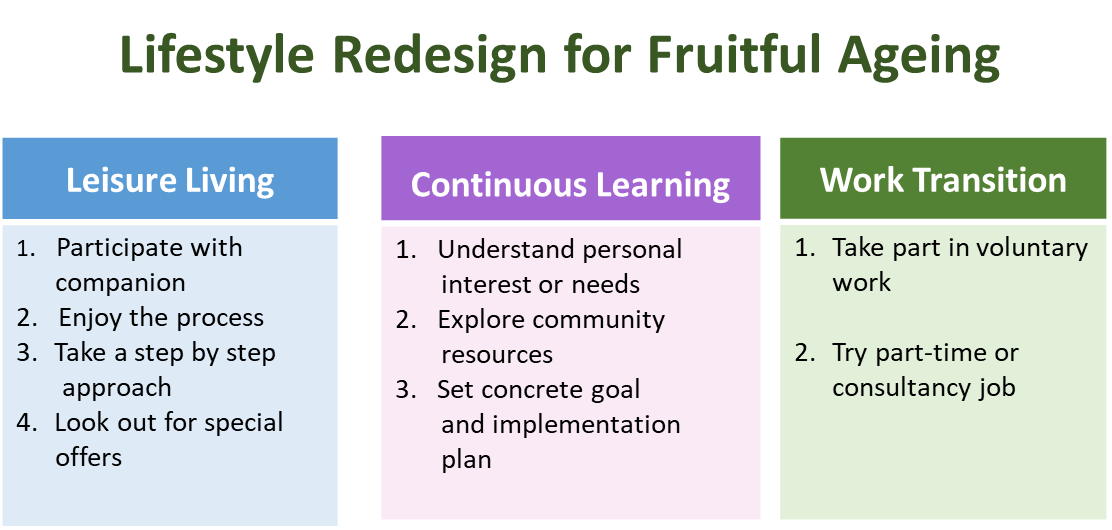Lifestyle Redesign for Fruitful Ageing
People discover personal value from their work, family life and leisure activities. After retirement, elderly persons not only need to adjust to the loss of their work life but also have to adapt to the abundance of time. This may make them feel disconnected from society.
The key to fruitful ageing is staying active in retirement.
Elderly persons can achieve a more enjoyable life through lifestyle redesign by “Leisure living”, “Continuous learning” and “Work transition”. Actively participating in meaningful activities and interacting with others can make life more fulfilling.


Leisure living refers to participating in leisure activities which could provide opportunities to make new friends, maintain physical and mental health, and improve quality of life. Some elderly persons may misunderstand that leisure activities are costly and require a lot of knowledge and skills, so they may be hesitant to participate. In fact, many leisure activities are not costly. Examples of common leisure activities include:
- Physical: taking a stroll, practising Tai Chi, etc.
- Recreational: listening to music, visiting exhibitions, etc.
- Social: participating in activities at the Elderly Centres, meeting with friends, celebrating festivals with family, etc.
- Cognitive: playing chess, playing computer/tablet games and learning to use the smartphone, etc.
Elderly persons can participate with companion to have more fun. Also, they should take a step-by-step approach depending on one’s circumstances, focus on enjoying the process and not care about gain and loss. Lastly, elderly persons could look out for special offers e.g. Elderly Travel Scheme, discounts and priority services provided by government departments, public institutions and businesses to increase the ease of participating. As long as you participate in different activities, you will find ones that suit you.

Continuous learning can help elderly persons keep up with the times, to adapt the changes in their health and lifestyle, and to enrich their lives. Depending on their personal interests and needs, elderly persons can explore suitable community resources, such as through online platforms, leaflets or visit to community facilities and service organizations in person, in order to set a concrete goal and implement a plan.
Elderly persons can learn continuously through the following ways :
- Utilise facilities of public institutions, e.g. museums, libraries and leisure facilities managed by the Leisure and Cultural Services Department
- Participate in courses offered by Non-governmental Organisations, e.g. the Elder Academy which provides diversified learning
- Utilise other self-learning methods, e.g. reading information from the internet, online courses, online videos and books, etc.

Work provides a platform through which people demonstrate their abilities, gain self-affirmation, meet new friends and expand their social circle.
Elderly persons can continue their contribution to society by work transition. For example, they may, based on their personal interests and personality, take part in voluntary work, such as participate in visits, charity sales, environmental recycling and other activities organized by alumni associations, staff clubs, religious group or Elderly Centres, so as to help those in need. Alternatively, they may take part in public welfare or social affairs, to promote community development as part of their new chapter of life. By participating in voluntary work, the quality of life and life satisfaction of the elderly persons can be improved.
Moreover, they can also consider to try part-time or consultancy job to develop their strengths in different positions.
Conclusion:
Lifestyle redesign is a process of promoting health. Through “leisure living”, “continuous learning” and “work transition”, elderly persons can reinforce their personal value, promote physical, mental, spiritual and social health, and lead a vibrant and fruitful life.